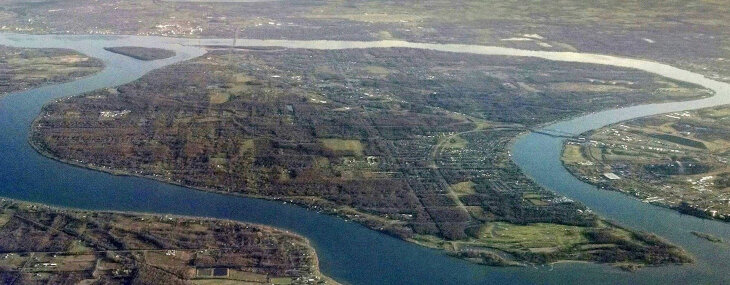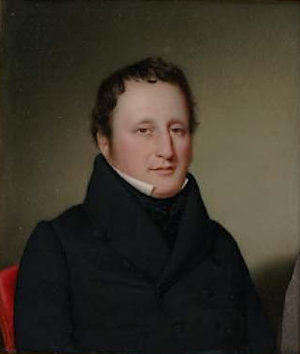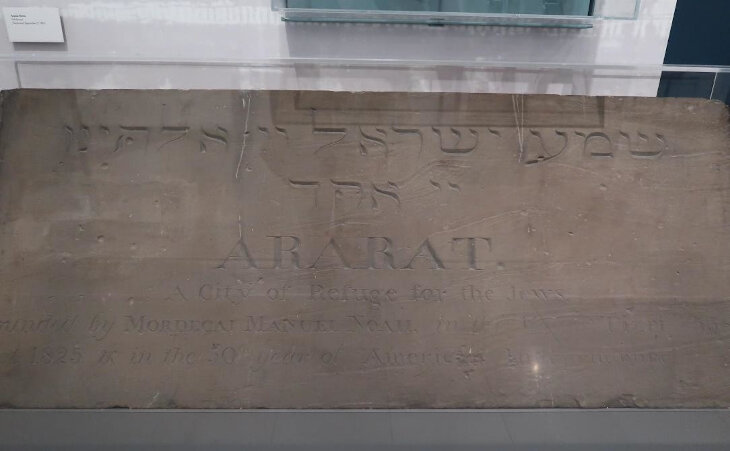 Raise a Glass to Freedom
Raise a Glass to Freedom


6 min read
How a small island in the Niagara River almost became home to a Jewish haven in the early 1800’s.
How did Grand Island, a 33.3 sq. mile island located in the Niagara River sandwiched between Canada and the United States, almost become a temporary haven for the Jewish people in 1825?
 Grand Island
Grand Island
Flashback to the early 1800’s. There was no Jewish state. The area referred to as Palestine was under the authority of the Ottoman Empire, which treated Jews as second-class citizens throughout the Middle East and North Africa. Jews in Western Europe were becoming integrated and assimilated into European society, meanwhile antisemitism remained prominent in Eastern Europe. 
Jews throughout the world were struggling to be seen as equals. The United States of America was just 50 years old; a country of immigrants, religious freedom and unlimited opportunity. Seems like a pretty good place to build “A City of Refuge for the Jews”, no?
Well, that’s what Mordecai Manuel Noah thought. Noah was an early American Jew born to German Ashkenazi and Portuguese Sephardic parents in Philadelphia in 1785. He became a politician and a journalist in New York City, where he made a name for himself.
In 1813, he was appointed as Consul to the Kingdom of Tunis, which granted him the ability to travel around North Africa and Europe. Noah saw firsthand the terrible conditions under which his Jewish brethren were living, igniting his inner desire to establish a temporary safe haven - a City of Refuge - for the Jewish people until they could return to Zion, their ultimate homeland.
The United States had acquired Grand Island from the Seneca Nation in 1815, and in 1820, Noah petitioned in front of the New York legislature to purchase it as a colony for the Jews. While he was biding his time to save enough money to purchase that land, he continued to advocate for his vision. He thought Grand Island was the perfect place – the open land could even re-ignite the ancient agricultural practices of the Jewish people which were, for the most part, lost in the Diaspora.

In 1825, he had finally saved enough money to purchase 3.9 sq. miles of the island for the City of Refuge for the Jewish Nation which he called Ararat. (Interestingly, Ararat was the name of the biblical land upon which Noah’s ark had landed, and the idea of a city of refuge is found in the Torah itself, although used for entirely different purposes.)
Noah, being the politician and journalist that he was, knew how to get the word out. He championed his idea in newspapers throughout the state, and to rabbis across the world in Europe. People far and wide heard about the proposed Jewish City of Refuge.
On September 15th, 1825, Ararat’s inauguration was held at a church in the nearby city of Buffalo; there were not enough boats to transport the crowds of people to the island for the ceremony. Noah led a jubilant procession, resplendent with prayers in Hebrew, loud music, singing, military troops, officers, clergymen, and fellow citizens. According to a New York City newspaper reporting on the event, Noah was “in black, wearing the judicial robes of crimson silk, trimmed with ermine and a richly embossed gold medal suspended from the neck” which historian Jonathan D. Sarna explains was lent by the local Park Theater.
Hundreds of people gathered to listen, including the Seneca Chief Red Jacket who arrived by boat (Noah believed that the Native Americans were one of the Lost Tribes).
In his speech, Noah proclaimed himself as the “Judge of Israel,” established Ararat as a City of Refuge, and claimed that every Jew in the world must be taxed “three shekels of silver” in order to sustain Ararat. He also decreed that every four years the Paris Jewish consistory was to elect a Judge of Israel (after Noah served his term, of course).
His animated speech was delivered to an audience mainly consisting of Protestant Christians, as most Jews viewed him as an imposturous Messiah and rejected his idea. At the end of the event, a large stone (pictured below) was unveiled, which was inscribed to commemorate the day of establishment of Ararat.
Alas, Ararat never came to fruition, and the stone is now located in the Buffalo History Museum in Downtown Buffalo. It reads:
 “(in Hebrew) Shema Yisrael Adonai Eloheinu Adonai Echad
“(in Hebrew) Shema Yisrael Adonai Eloheinu Adonai Echad
ARARAT
A City of Refuge for the Jews
Founded by Mordecai Manuel Noah in the year Tizrei 5586,
Sept. 1825, in the 50th year of American Independence.”
The crowd cheered and sang with Noah, but this was not the crowd he needed to bring his vision to life. American Jews were largely absent and saw no need for a City of Refuge. They were comfortable in America and ridiculed Noah for acting as a self-appointed “Messiah.” The integrated Western and Central European Jews felt the same way. Noah’s written proclamation was suppressed by the Austro-Hungarian Empires and it didn’t even reach the ears of Eastern European Jews. Nor did it reach the Jewish communities in North Africa and the Middle East.
 South Grand Island Bridge
South Grand Island Bridge
After his failure, Noah spent his life advocating for rebuilding a Jewish homeland in Palestine, believing that Jewish sovereignty in Zion would provide the only long-term security for the Jews.
Noah, who predated the establishment of the First Zionist Congress led by Theodor Herzl by 72 years, did not live see the establishment of a Jewish State, but his unwavering dedication and passion for his people is a testament to the resolve of Jewish visionaries to seek out pathways that ensure that the Jewish nation not only survives, but thrives.
So, the next time you’re visiting the Niagara Falls, remember Ararat, the City of Refuge for the Jewish People that almost was.
Bibliography:
Gordis, Robert. “MORDECAI MANUEL NOAH: A CENTENARY EVALUATION.” Publications of the American Jewish Historical Society 41, no. 1 (1951): 1–26. http://www.jstor.org/stable/43059806.
Sarna. (1981). Jacksonian Jew: the two worlds of Mordecai Noah (p. xi, 233 pages;). Holmes & Meier Publishers.
